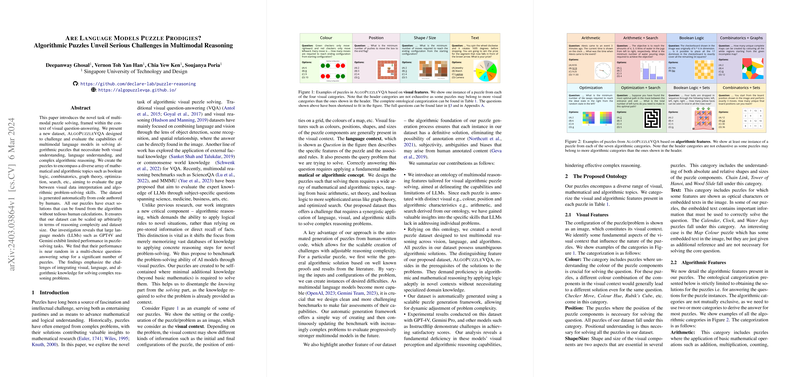Algorithmic Puzzles Unveil Serious Challenges in Multimodal Reasoning
Introduction
Puzzles have long been a fascination for both humans and artificial intelligence systems, offering a clear platform to challenge and benchmark reasoning capabilities. The research paper presents \textsc{AlgoPuzzleVQA}, a novel dataset designed to push the boundaries of current multimodal LLMs in solving algorithmic puzzles that require an understanding of visual clues, language processing, and, critically, complex algorithmic reasoning. This dataset serves as a unique evaluation tool, aiming to understand the extent and limitations of LLMs in integrating visual, linguistic, and algorithmic knowledge to solve puzzles that are algorithmically exact but require significant reasoning depth.
Defining the Challenge
The challenges presented in \textsc{AlgoPuzzleVQA} extend beyond the traditional bounds of Visual Question Answering (VQA) tasks. While VQA tasks have traditionally focused on object detection, scene recognition, and basic inferential reasoning based on visual features, \textsc{AlgoPuzzleVQA} introduces puzzles that demand an additional layer of algorithmic reasoning. This necessitates the models to not only interpret visual and textual information but also engage with the problem at a mathematical and algorithmic level. The dataset achieves this by featuring puzzles that range broadly over topics like boolean logic, combinatorics, optimization, and graph theory.
Dataset Overview and Generation
\textsc{AlgoPuzzleVQA} was generated using a scalable puzzle generation framework, ensuring puzzles have exact solutions derivable from algorithms without resorting to exhaustive human calculation. This approach not only guarantees the clarity and precision of the dataset but also its extensibility, allowing for an arbitrary increase in reasoning complexity and dataset size.
The dataset is categorized into visual and algorithmic features, providing a clear ontology for understanding the range and type of reasoning skills being evaluated. Visual features include aspects such as color, position, shape/size, and text embedded in the image, while algorithmic features span arithmetic, boolean logic, combinatorics, graphs, optimization, search, and sets.
Experimental Findings
Upon evaluating leading LLMs including GPT-4V and Gemini Pro on the \textsc{AlgoPuzzleVQA}, findings reveal that these models demonstrate limited capability in solving the puzzles, often performing near-random choice accuracy across many puzzles. This highlights a fundamental challenge that exists in the integration of visual perception with complex algorithmic reasoning. However, when the models are provided with explicitly described visual contexts, their performance sees a marginal improvement, suggesting that the existing bottleneck might not solely lie in algorithmic reasoning but also in visual understanding.
Implications and Future Directions
The results from exploring \textsc{AlgoPuzzleVQA} have several implications. Firstly, they suggest that despite the significant progress in multimodal LLMs, there remains a substantial gap in their capability to perform complex reasoning that integrates visual understanding with algorithmic problem-solving. This identifies clear avenues for future research in enhancing the synergistic capabilities of LLMs across different modalities.
Furthermore, the dataset's unique focus on algorithmic reasoning opens up new possibilities for benchmarking AI models not just on their knowledge recall or pattern recognition abilities, but on fundamental reasoning and problem-solving skills.
Conclusion
In conclusion, \textsc{AlgoPuzzleVQA} serves as an innovative tool for probing the depths of AI’s multimodal reasoning capabilities, revealing critical gaps and underscoring the importance of nurturing models' algorithmic reasoning faculties. As AI continues to evolve, datasets like \textsc{AlgoPuzzleVQA} will play a crucial role in guiding progress toward models that can seamlessly integrate visual, linguistic, and algorithmic intelligence to solve complex challenges.
